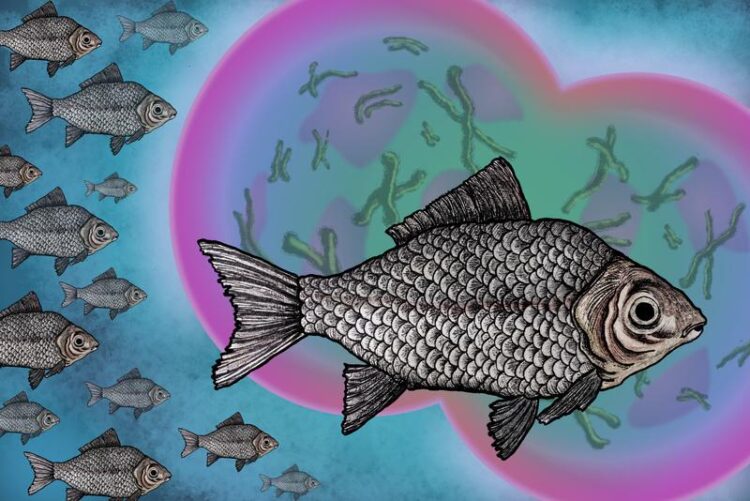Invasive fish: Sperm hijacking as success strategy

The Prussian carp reproduces mainly through partheogenesis. The produced offspring are clones of the female.
Credit: Fabian Oswald
Researchers decode the unusual genome of the Prussian carp.
The Prussian carp is considered one of the most successful invasive fish species in Europe. Its ability to reproduce asexually gives it a major advantage over competing fish. An international research team has now managed to describe the complete genome of the Prussian carp for the first time. This also provides a much better understanding of its peculiar reproductive method. The study, led by Dunja Lamatsch from the Research Department for Limnology of the University of Innsbruck, Austria, was published in the journal Nature Communications.
The Prussian carp (Carassius gibelio), native to Asia, is an invasive species in Europe. It is a close relative of the goldfish, and competes with the endangered native crucian carp for the same habitat. However, while goldfish and crucian carp usually reproduce sexually, the Prussian carp has a major evolutionary advantage: females can save the time-consuming search for a mate.
Parthenogenesis in the water
Instead, female Prussian carps use sperm of male crucian carps, or other carp species. To do this, they intermingle with a school of crucian carp, where their laid eggs are fertilized by the males.
The hijacked sperm stimulates the egg cell of the Prussian carp to divide. The genetic material of the male is then broken down in the egg cell without being used. This is called sperm-dependent parthenogenesis, or virgin production. All offspring produced this way are female clones of the Prussian carp female. Most Prussian carp populations are therefore exclusively female, males occur only rarely.
“Unisexual, or purely female reproduction enables rapid colonization of new habitats and offers invasive species a major advantage over their original competitors,” explains Dunja Lamatsch from the Research Department for Limnology of the University of Innsbruck, based in Mondsee, Austria. Her research focuses on studying the mechanisms of unisexual reproduction in aquatic organisms.
In a study initiated by Lamatsch, she and an international team of researchers were able to completely decode the genome of the Prussian carp. As a result, the mechanism behind its unisexual reproduction can now be better understood.
Hybridity leads to new species
The total heritable information of an organism, the genome, is divided into different sets of chromosomes. Animals that reproduce sexually usually have a double (diploid) set of chromosomes. For reproduction, the chromosomes of females and males are divided into germ cells (meiosis) and only one single (haploid) set of chromosomes is passed on at a time. The fusion of a haploid egg and a haploid sperm finally restores a diploid organism.
However, accidents during meiosis or crossbreeding of related species repeatedly result in organisms that have more than 2 sets of chromosomes (polyploid). Polyploid higher vertebrates are not viable, but fish, amphibians, and reptiles are. Even new species can evolve this way- like the Prussian carp.
Origin of unisexuality
The Prussian carp is hexaploid- this means that it has six sets of chromosomes. Four of them came together by crossing unrelated fish species – the other two were added by crossing with a closely related fish.
“Presumably, at some point during these crossings, problems occurred in the formation of the gametes. That could be one of the triggers of unisexual reproduction,” Lamatsch explains. “In species that reproduce parthenogenetically, meiosis fails, and fusion of gametes is no longer necessary.”
In cooperation with research groups from the Leibniz Institute of Freshwater Ecology and Inland Fisheries in Berlin (IGB) and the University of Würzburg, it was possible to dissect the genome of the Prussian carp into individual chromosome sets. This is the first time that the entire genetic information of a hexaploid animal has been described, and all six sets of chromosomes have been analyzed. The genome of the Prussian carp consists of a total of 150 chromosomes, more than three times as many as the human genome.
The analyses shed light on how these six sets of chromosomes can coexist and work together. The identification of all 150 chromosomes makes it possible for the first time to understand the entire genome structure of the Prussian carp as well as its complicated evolutionary history. This opens up many more interesting research questions around the invasive fish.
Journal: Nature Communications
DOI: 10.1038/s41467-022-31515-w
Method of Research: Observational study
Subject of Research: Animals
Article Title: Equilibrated evolution of the mixed auto-/allopolyploid haplotype-resolved genome of the invasive hexaploid Prussian carp.
Article Publication Date: 14-Jul-2022
COI Statement: The authors declare no competing interests.
Media Contact
All latest news from the category: Agricultural and Forestry Science
Newest articles

Tackling Life-Threatening Fungal Infections Using RNA Modifications
Importance of RNA modifications for the development of resistance in fungi raises hope for more effective treatment of fungal infections. An often-overlooked mechanism of gene regulation may be involved in…

Unraveling Aphasia: Global Study Breaks Down Patients’ Struggle with Verb Tenses
An international team of researchers, including scientists from the HSE Centre for Language and Brain, has identified the causes of impairments in expressing grammatical tense in people with aphasia. They discovered…

Facing the Storm: A Prepped Up Future Against Extreme Climatic and Weather Changes
From the persistent droughts of southern Africa and Central America in the early part of the year to the more recent devastating extreme rainfall in Spain and the deadly Hurricane…



